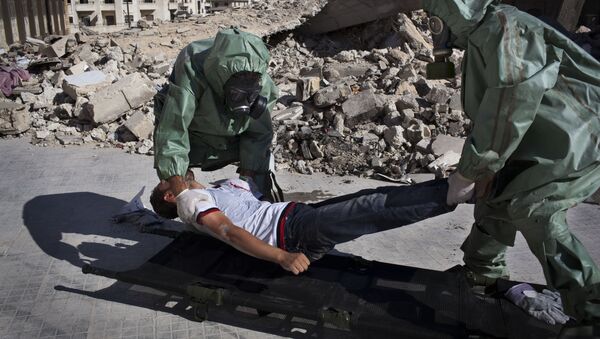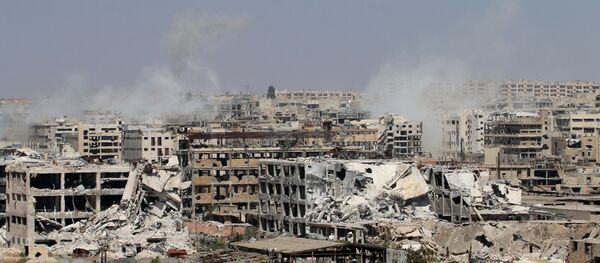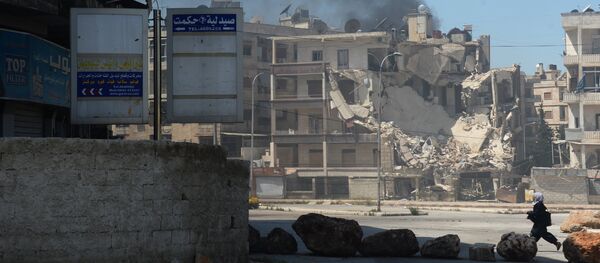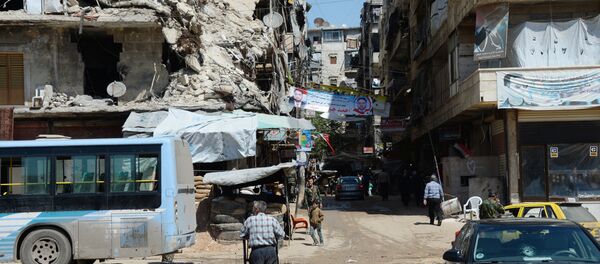Western media has never missed a chance to point the finger of blame at Damascus for an alleged use of chemical weapons in Syria, Jean Perier, a French researcher and expert on Middle Eastern affairs writes in his article for New Eastern Outlook.
However, the expert points out, the West usually shies away from lambasting the so-called Syrian rebels when they are spotted using poisonous gas.
On August 2, 2016, the US-backed Harakat Nour al-Din al-Zenki militant group launched a toxic gas attack in the Syrian city of Aleppo, killing at least seven and injuring 23 people, according to the Russian Center for Syrian Reconciliation.
The bombs were suspected to contain chlorine gas.
Although the American side was informed by Russia about the deadly attack carried out by the US-backed "moderate" rebel group, the US media remained surprisingly silent on the matter.
Instead, the Western media sources reported the same very day that "a helicopter dropped containers of toxic gas overnight on a town [Saraqeb] close to where a Russian [Mi-8 transport] helicopter had been shot down hours earlier," citing the so-called Syria Civil Defense group. The group claimed that 33 people were affected by the alleged attack.
The assault was blamed on Syrian President Bashar al-Assad, although no evidence was provided to confirm the allegation.
About three years ago a series of chemical attacks in Syria was also blamed on Bashar al-Assad. However, the United Nations independent commission of inquiry on Syria has not found any strong evidence of Syrian government forces being behind the attacks.
Quite the contrary, commission member Carla Del Ponte, a former Swiss attorney-general, stressed that there were "strong, concrete suspicions" that "this was use [of chemical weapons] on the part of the opposition, the rebels, not by the government authorities" in an interview with Swiss-Italian television.
Interestingly enough, in response to Carla Del Ponte's remark, the Syrian National Coalition as well as American and British officials instantly denied that rebel fighters could launch the attacks.
"US officials… said Washington had no information to suggest Syrian rebels had the capability or intention to use Sarin," BBC wrote in May 2013.
However, in December 2015 SANA reported that Syrian authorities seized "equipment for using chemical weapons, as well as medical supplies and equipment of Turkish, Saudi, and Qatari origins" which belonged to Syrian rebels in Latakia's northern countryside.
"So how could one explain such inconsistent policies implemented by the White House? It's clear that it is trying to punish some players for alleged violations of the Convention on the Prohibition of the Development, Production, Stockpiling and Use of Chemical Weapons and on their Destruction, while at the same ignoring facts of chemical attacks are being launched by non-state actors in Syria," Perier asks.
Back in 2002 the Guardian reported, citing declassified papers, that the US "allowed" the export of "biological agents, including anthrax" and "vital ingredients for chemical weapons" to Iraq during the Iran-Iraq war (1980-1988).
"A 1994 congressional inquiry… found that dozens of biological agents, including various strains of anthrax, had been shipped to Iraq by US companies, under license from the commerce department. Furthermore, in 1988, the Dow Chemical company sold $1.5m-worth (£930,000) of pesticides to Iraq despite suspicions they would be used for chemical warfare," the media outlet noted.
Decades later US chemical weapons found their way to Iraq again.
"The documents that [whistleblower Bradley] Manning handed over to Wikileaks stated that the Pentagon has delivered at least 2,386 pieces of chemical ordnance to Iraq," Perier narrates, citing a Wikileaks report.
"The United States has been caught with at least 2,386 'non-lethal' chemical weapons deployed in Iraq. The items appear in a spectacular 2,000 page leak of nearly one million items of US military equipment deployed in Iraq given to the government transparency group Wikileaks. The items are labeled under the military's own NATO supply classification 'Chemical weapons and equipment,'" the report stated.
Remarkably, in November 2005 BBC reported that American officials admitted that the US military used white phosphorus in the Iraqi city of Fallujah in 2004 as "an incendiary" to "flush enemy troops out of covered positions."
Commenting on the matter British writer George Monbiot wrote in his article for the Guardian on November 15, 2005:
"Did US troops use chemical weapons in Fallujah? The answer is yes… White phosphorus is not listed in the schedules of the Chemical Weapons Convention. It can be legally used as a flare to illuminate the battlefield, or to produce smoke to hide troop movements from the enemy. But it becomes a chemical weapon as soon as it is used directly against people."
Monbiot noted that since the US admitted that it used white phosphorus directly against people, it meant it used white phosphorus in Fallujah as chemical weapons.
Before groundlessly accusing the Syrian government of launching chemical attacks against its people, Washington should reconsider its double standard approach toward the use of chemical weapons.




